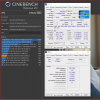Have you ever heard about
heavy AVX loads, son? Intel implemented different sets of multipliers in the 3rd version of xeon family for AVX load simply because v2's were unable to fit into the claimed TDP under AVX load and sustain the all core turbo (leading to turbo throttling).
And yep, E5 2696 v2 has TDP of 120w only. Even much more power-efficient v4 will require 145w to sustain 3.2GHz all 12-cores turbo under heavy load, no way older Ivy Bridge will fit into 120W. Doubt it? Linpack can prove it to you. Simply run it and watch how your all-core multiplier is melting under the real load (not fake UserBenchmark load).














